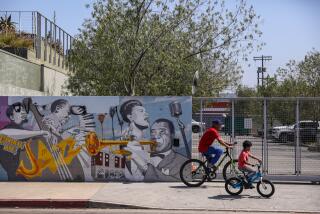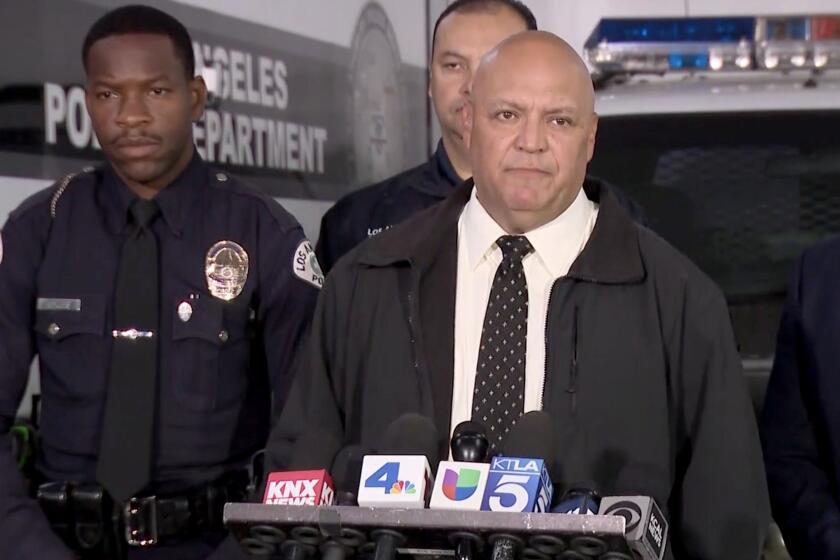Column: How Latinos raised in Southern California are changing politics in small-town America
As Rudy Monterrosa wrapped up his final year at Notre Dame Law School in 1998, he also readied a return to Southern California.
South Bend, Ind., had treated him well, but the son of Mexican and Salvadoran immigrants didn’t see a future there. His family and friends lived in unincorporated Bloomington in San Bernardino County. He was a volunteer with the Inland Empire Future Leaders Program, which has trained generations of high schoolers to better their communities.
And that’s what Monterrosa planned to do back home — set up a law practice, then eventually enter politics.
But one night, he served as an emcee when Edward James Olmos came to Notre Dame. Latinos drove for hours from across the Midwest to hear the actor speak, thirsty for a touch of their culture and for an event where they weren’t an anomaly, at only about 8% of the population.
“Something clicked,” Monterrosa now says. “It made me realize we can make a difference here.”
So he gave himself five years to try to establish a life. He became a respected leader, the type of guy whose career allowed him to cross paths with former South Bend Mayor Pete Buttigieg and the husband of newly confirmed Supreme Court Justice Amy Coney Barrett. Meanwhile, the Latino population in South Bend and the surrounding region doubled.
By 2018, Monterrosa achieved the dream he once imagined for himself in California: immigration lawyer, Notre Dame law professor and school board member.
He’s running for reelection on the South Bend Community School Corp. board this year as one of the few Latino politicians in the Hoosier State.
And he’s doing it as a voice from the future — as a Californian who has already been through the demographic changes that an increasingly diverse Midwest is now confronting.
“The issues that California went through in the 1980s and ‘90s, like bilingual education and discrimination, the stuff I lived through, are just coming to Indiana,” said Monterrosa, who is 47.
He’s on the board of Inland Empire Future Leaders and still returns to San Bernardino County every year to volunteer at the nonprofit’s summer camp.
“Our students can see someone like them in me, and their parents can see someone who was once in their children’s exact position,” he said.
That Golden State state of mind is slowly starting to pop up in corridors of power across small-town America.
Latinos raised in California sit on a community college board in Nebraska, a city council in suburban Virginia and in the Maryland House of Delegates. They’ve become the first Hispanic ever elected to political office in Kentucky and are climbing New Hampshire’s governmental ladder.
This phenomenon is so new that the National Assn. of Latino Elected and Appointed Officials, which keeps a database of the more than 6,000 Latinos who hold public office in the U.S., has no hard numbers on how many politicians like these exist.
But NALEO Chief Operating Officer Erica Bernal-Martinez says she’s “excited” by the development.
“It’s going to make these communities stronger in the long term,” she said. “They bring these [California] ideals and convince people locally that they’re one of them.”
So let me introduce you to three electeds who illustrate this point in different ways: Monterrosa, New Hampshire state representative Manny Espitia and Christine Thompson, a school board member in a tiny Kentucky county where the Latino population is just 2.5%.
Monterrosa was the one who grew up alongside an emerging Latino community. There was only one Latino lawyer in all of South Bend when he attended Notre Dame. Monterrosa’s mere presence and his fluency in Spanish made him sought-after almost immediately.
“An activist went up to me shortly before I graduated and told me, ‘Rudy, we need you here,’” he said. “‘Don’t leave.’”
He eventually become president of the board of directors for La Casa de Amistad, a local community space, and volunteered for other Latino-focused groups across Indiana. Running for office was always “at the back of my mind,” but Monterrosa preferred to just focus on his law practice.
By the time there was a vacant spot on the South Bend Community School Corp. board two years ago, Monterrosa was a logical choice for the appointment.
“He knows what it takes to be a leader out in California, where he’s one Latino amongst many,” said R.C. Heredia, chair of Inland Empire Future Leaders. “In South Bend, not so much. But he takes his pride and leadership that he learned with us and adapted it in order to have an impact.”
That’s the same approach Espitia is taking in New Hampshire, where Latinos make up only 4% of the population. The Santa Ana native has lived in the Granite State only since 2015, landing there to work on Hillary Clinton’s presidential campaign. After stints on the staffs of Nashua’s mayor and U.S. Sen. Maggie Hassan, Espitia ran for state representative in 2018, at the urging of Democratic leaders. He remains one of just two Latinos in the state’s 400-member House of Representatives.
His district has the largest concentration of Latinos in New Hampshire, yet he finds himself fighting for “basic stuff,” like government communication in Spanish — things so commonsense in California that we forget the rest of the country isn’t like us.
“Nashua is becoming diverse, and [native New Hamsphirites] have to break out of their homogenous mindset,” said the 30-year-old, who just bought a home with his fiancée but will keep his cellphone’s 714 area code for the foreseeable future. “Being able to get people to adjust their minds that different populations have different obstacles is tough. But we fought those battles in California long ago.”
Both Espitia and Monterrosa moved away from California as adults. Thompson, the daughter of immigrants from Mexico City and Nayarit, arrived in Paducah, Ky., from Riverside with her family when she was 14.
“That shock of being in that new environment was very difficult for me,” said the mother of two. “Especially being a teenager. You want to fit in, you don’t want to stand out — and you stand out.”
Thompson stayed in western Kentucky with her family, who liked the slower pace of life and the lower cost of living. She entered the nonprofit world and became a familiar community presence, lately as executive director at Paducah-McCracken County Senior Center.
But when she decided to run for the Livingston County school board in 2018, she had her 14-year-old self in mind.
“Growing up here as the daughter of immigrants, as a newcomer, that’s a way for me to advocate for quality education” for her rural constituents, said the 37-year-old. “I bring those lived experiences to the table. That really keeps me going — being a role model and that inspiration for other kids to look up to.”
People like Thompson, Espitia and Monterrosa are powerful — both symbolically and literally. Not only do their actions affect the lives of their constituents, but they also serve as ambassadors for Latinos nationwide — and for the California way.
“California made me who I am,” Monterrosa said, choking up. “And that same spirit that I grew up with is the same one that I keep with me in South Bend.”
More to Read
Start your day right
Sign up for Essential California for news, features and recommendations from the L.A. Times and beyond in your inbox six days a week.
You may occasionally receive promotional content from the Los Angeles Times.







